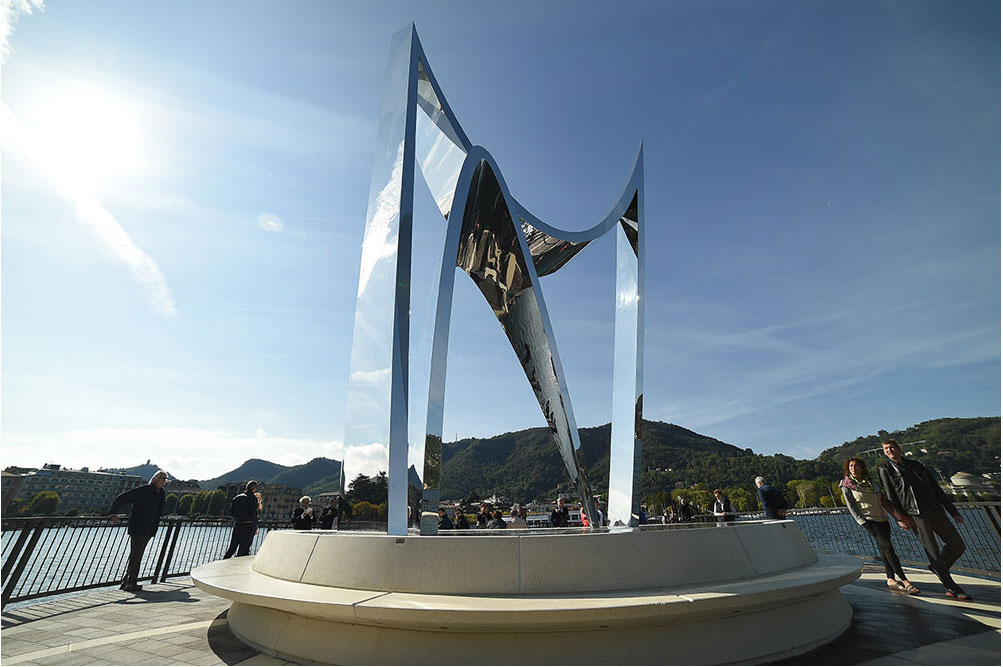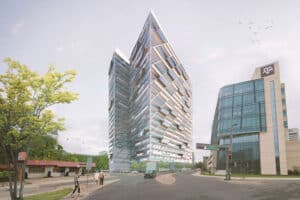This article was published in La Provincia by Bruno Profazio, and has been translated from its original Italian.
There are four children, ideally under the Life Electric monument inaugurated yesterday in Como. The first is Alessandro Volta himself, a scientist and benefactor of humanity, to whose memory the monument is dedicated. Volta was a late bloomer who, according to testimonies, began to speak only at seven years old and showed an interest in the shiny straws in the Cosia stream in Camnago.
The second child lived in Lodz, a Polish Jew, and his father Nachman, having overcome the horrors of war and persecution, loved to distract with the game of the electric battery: he connected two wires and the light bulb lit up. That child was Daniel Libeskind.
The third child is the one who will be taken by their mom and dad this afternoon to see Como’s novelty. That bright and darting sculpture in the roundabout of the external dam. It can be seen from Piazza Cavour and encourages you to go under it to admire it up close. We imagine this child unaware of the controversies that have accompanied the creation of the work. Today, the opposition and discussions fade into the placid rippling of the lake and blend into the play of lights and reflections of the monument. Free from these adult roughnesses, the child will amusingly reflect on the reflective surfaces and perhaps laugh. Their laughter will bury the past criticisms.
The fourth child will be born in twenty years, and for them, the monument to Volta will have always been there, becoming part of the city that they will begin to know and in which they will grow up, perhaps dreaming of creating one with their own hands one day. Who knows what technological objects they will bring on the walk and with which smartphone or gadget yet to be invented they will store that image to preserve or share it with friends. Life Electric is dedicated primarily to them, to this child who will come.
Daniel Libeskind said it well, indicating that his work wants to be a gift to the Como of the future.
We are all in that child. We are with all the projects, desires, and expectations of the time that we do not know. Since yesterday, our city sees a piece of its future. “Cities – Daniel and Lev Libeskind wrote on Sunday in ‘L’Ordine’ – much more than nations, are becoming places where you can observe in advance what our tomorrow will be like.”
The Libeskind monument represents many things. The desire for the future of a city that lives on beauty.
The ability and industriousness of the citizens who, united in the Associazione Amici di Como, have shown that love for the place where you live is expressed primarily through generosity: the sculpture is their gift to the community.
The determination and willpower that animate those who fight for a cause in which they firmly believe. Today it seems like a game, and on the day of celebration, it is better not to dredge up and blame. But how did those who gave the city a work of art of immense value feel when treated like any commercial company: you have to pay VAT, yes, even if it’s a gift? Or the double service conference. And the wasted time. And the endless paperwork?
Fortunately, they continued, and today Como can boast an extraordinary title: it has done better than any other Italian city, including Milan, because it is the only one that realizes a work that remains in the year of Expo. Next to splendid monuments such as the Casa del Fascio, the Duomo, the Monument to the Fallen, the Tempio Voltiano, there is now Life Electric dedicated to Volta.
Libeskind wrote that he likes to think that the energy discharge of the monument represents the spirit of the people of Como.


